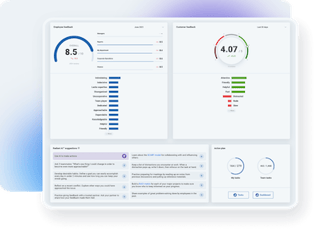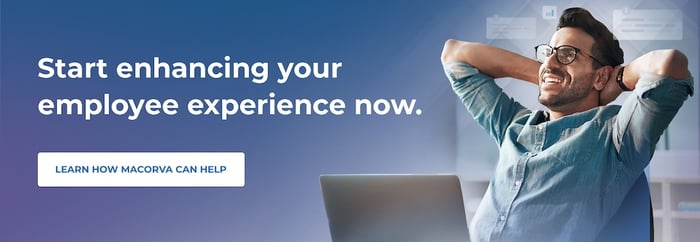What is Employee Experience?
A Complete Guide

What is Employee Experience?
A Complete Guide

What is Employee Experience
In today's dynamic business landscape, where talent acquisition and retention are paramount, organizations are recognizing the immense value of fostering a positive employee experience (EX). EX encompasses the entire employee journey, from recruitment to onboarding, development, performance evaluation, and offboarding. It's the culmination of all interactions, touchpoints, and experiences that shape an employee's perception of their workplace.
The Power of Employee Experience on Business Outcomes
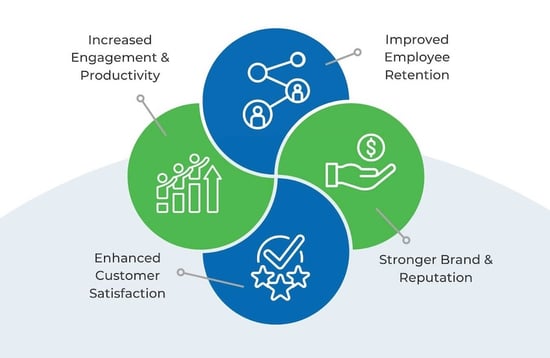
By prioritizing EX, organizations can reap significant business benefits, including:
Increased Employee Engagement and Employee Productivity
A positive EX fosters a sense of connection, purpose, and motivation among employees, leading to higher engagement levels. Engaged employees are more likely to be productive, innovative, and committed to the organization's success. Studies have shown that engaged work units have 21% higher profitability compared to those with low engagement.
Consider this case study: Google, which has been consistently recognized as one of the most sought-after employers, attributes its high employee engagement rates to its focus on EX initiatives such as its "20% time" policy, which encourages employees to spend 20% of their time working on innovative projects that align with their interests.
Improved Talent Attraction and Employee Retention
A strong EX acts as a magnet for top talent, attracting individuals who seek a fulfilling and rewarding work environment. By nurturing a positive EX, organizations can reduce employee turnover, saving the significant costs associated with recruiting and onboarding new hires.
Consider this case study: Airbnb has a notoriously competitive job market, but its strong EX initiatives, including its focus on company culture and diversity and inclusion, have helped it attract and retain top talent, contributing to its rapid growth and success.
Enhanced Customer Satisfaction and Loyalty
A positive EX has a ripple effect that extends beyond the walls of the organization. Engaged employees are more likely to deliver exceptional customer service, fostering positive customer experiences and fostering brand loyalty.
Consider this case study: Southwest Airlines has consistently ranked among the top companies for customer satisfaction due in part to its focus on EX. The airline's employee-centric culture, which emphasizes teamwork, recognition, and fun, has created a positive work environment that translates into exceptional customer service.
Stronger Employer Brand and Reputation
A strong EX contributes to a positive employer brand, enhancing the organization's reputation in the industry and among potential employees. A recent study found that companies with strong employer brands have a 43% lower employee turnover rate.
Consider this case study: Salesforce, a cloud-based software company, has built a strong reputation as a great place to work, attracting top talent and boosting its brand image. The company's EX initiatives, such as its "Work.com" platform that promotes flexibility and remote work options, have resonated with employees and potential candidates.
Increased Innovation and Adaptability
A positive EX encourages employees to contribute their ideas, fostering a culture of innovation and adaptability. Research from MIT CISR found that “Companies with scores in the top quartile of employee experience were twice as innovative as those in the bottom quartile, based on the percentage of revenue from new products/services in the past two years. These companies were paving the way for employees to work together effectively and engage with customers in new ways to enhance revenue streams.”
Reduced Absenteeism and Presenteeism
A positive EX promotes employee well-being, leading to reduced absenteeism and presenteeism (being physically present but not fully engaged). This contributes to a healthier and more productive workforce.
Consider this case study: A Deloitte study on UK workplace trends found that companies that invested in improving employee experience through mental health and well-being services experienced an average 5:1 return on investment.
Enhanced Risk Management and Compliance
A positive EX reduces the risk of legal and reputational damage associated with employee grievances and misconduct. A positive workplace culture promotes ethical behavior and compliance with regulations.
Components of Employee Experience
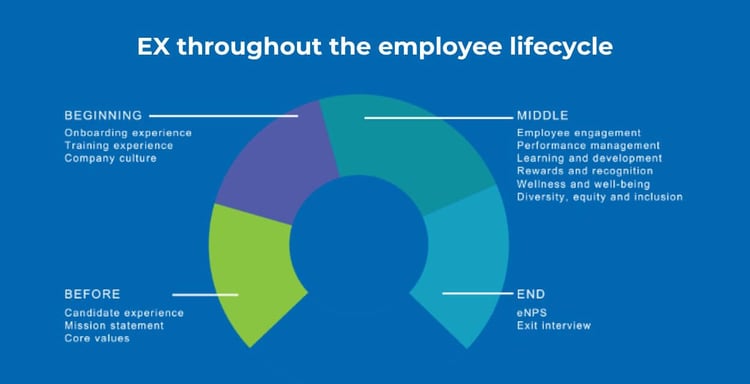
Employee experience encompasses a broad spectrum of factors that influence how employees feel about their work and their organization. These can be grouped into key phases of the employee lifecycle:
Each phase of the employee lifecycle plays a critical role in shaping the overall EX. A positive EX can lead to increased employee engagement, productivity, and retention, while a negative EX can result in disengagement, attrition, and a damaged employer brand.
Employee Lifecycle: Before
The Before phase, also known as the pre-employment phase, sets the stage for the entire employee experience journey. It encompasses the candidate experience, the organization's mission statement, and its core values. A positive candidate experience, with a well-structured application process, engaging interviews, and timely communication, creates a favorable first impression and attracts top talent. A clearly articulated mission statement and consistently upheld core values provide direction, purpose, and a sense of belonging to potential employees, drawing them to the organization. By investing in the Before phase, organizations can foster a strong employer brand, attract high-quality candidates, and lay the foundation for a positive and productive employee journey.
Candidate Experience
The candidate experience is the first impression an organization makes on potential employees. A positive candidate experience can attract top talent and set the stage for a successful employee journey.
Mission Statement
An organization's mission statement reflects its purpose and values, providing employees with a sense of meaning and direction. A clear and inspiring mission statement can foster a sense of belonging and shared purpose among employees.
Core Values
Core values define the organization's principles and beliefs, guiding how employees interact with each other, customers, and stakeholders. Strong core values can create a positive and ethical work environment.
Employee Lifecycle: Beginning
The Beginning phase of employee experience encompasses the initial period of employment, including onboarding, training, and early interactions with colleagues and managers. This phase is crucial for setting the tone for the employee's entire journey and establishing their perception of the organization. A positive Beginning phase fosters a sense of connection, belonging, and confidence, leading to increased engagement, productivity, and retention. Organizations that invest in effective onboarding programs, provide comprehensive training, and foster a supportive work environment can create a strong foundation for a successful employee experience journey.
Employee Onboarding
The recruiting and onboarding experience sets the tone for a new employee's relationship with the organization. A well-structured onboarding program can help new hires feel welcomed, supported, and integrated into the company culture.
Employee Training
Providing employees with adequate training and development opportunities empowers them to perform their jobs effectively, grow their skills, and contribute to the organization's success.
Company Culture
An organization's culture encompasses its shared behaviors, values, and beliefs. A positive and inclusive company culture can foster a sense of belonging, engagement, and productivity.
Employee Lifecycle: During
The During phase encompasses the employee's day-to-day experiences, including onboarding, training, company culture, engagement, performance management, learning and development, rewards and recognition, diversity, equity, and inclusion, and wellness and well-being. It's the heart of the EX journey, where employees form their perceptions of the organization and build their careers. A positive During phase fosters engagement, productivity, and innovation, while a negative one leads to disengagement, turnover, and missed opportunities. By investing in the During phase, organizations can create a thriving workplace that attracts, engages, and retains top talent, driving long-term success.
Employee Engagement
Employee engagement is a critical component of EX, reflecting an employee's connection to their work, their colleagues, and the organization as a whole. Engaged employees are more likely to be productive, innovative, and committed to the organization's success.
- Employee Engagement Surveys: Regular employee engagement surveys provide valuable insights into employee satisfaction, morale, and areas for improvement.
- Employee Engagement Benchmarks: Comparing employee engagement data to industry benchmarks can help organizations identify their strengths and weaknesses and track progress over time.
- Drivers of Engagement: Understanding the key drivers of employee engagement, such as work-life balance, recognition, and opportunities for growth, is crucial for creating a more engaged workforce.
- Employee Sentiment Analysis: Analyzing employee feedback and communications using sentiment analysis tools can provide deeper insights into employee attitudes and concerns.
Performance Management
Effective performance management helps employees understand their expectations, receive constructive feedback, and set goals for their professional development.
- Manager Assessment: Regular manager assessments provide valuable feedback on their leadership skills, communication style, and ability to support employee growth.
- Employee Self-assessment: Regular self-assessments encourage employees to reflect on their performance, identify areas for improvement, and set personal development goals.
- 360 Feedback: 360 feedback provides employees with a comprehensive assessment of their performance from colleagues, managers, and clients.
- Objectives and Key Results (OKRs): Setting clear and measurable OKRs aligns individual performance with organizational goals, fostering a sense of purpose and contribution.
Learning and Development
Providing employees with opportunities for learning and development helps them acquire new skills, enhance their expertise, and advance their careers.
- Leadership Training: Investing in leadership training equips managers with the skills and knowledge to effectively lead, motivate, and develop their teams.
- Career Development: Supporting employees' career development through mentorship, coaching, and career planning programs helps them achieve their professional aspirations and contribute to the organization's long-term success.
- Succession Planning: Developing a succession plan ensures the organization has the talent and leadership pipeline in place to continue its success in the future.
Rewards and Employee Recognition
Recognizing and rewarding employee achievements fosters a sense of appreciation, boosts morale, and encourages continued high performance
Diversity, Equity, and Inclusion (DEI)
Fostering a diverse, equitable, and inclusive work environment where all employees feel valued, respected, and empowered is essential for a positive EX.
Employee Well-being
Providing resources and support for employee wellness and well-being, including physical and mental health, work-life balance, and stress management programs, contributes to a healthier and happier workforce.
Employee Lifecycle: After
The After phase of employee experience encompasses the post-employment period, including exit interviews, ongoing support, and maintaining connections with former employees. This phase is crucial for gathering valuable feedback, demonstrating ongoing care for employees, and preserving the organization's reputation. Conducting thorough exit interviews provides insights into areas for improvement and helps organizations retain top talent. Offering transition support and ongoing engagement opportunities demonstrates the organization's commitment to employee well-being and fosters positive brand perception. By investing in the After phase, organizations can maintain strong relationships with former employees, leverage their feedback for continuous improvement, and protect their employer brand.
Exit Interviews and Alumni Feedback
Exit interviews provide valuable insights into why employees are leaving an organization. By understanding the reasons for attrition, organizations can identify areas for improvement and prevent future losses.
Employee Experience Platforms
Employee experience platforms are software solutions that provide organizations with the tools and capabilities to effectively manage and improve the employee experience. These platforms offer a range of features that can help organizations collect and analyze employee experience data, implement employee experience initiatives, and measure and track progress.
Employee Experience Management
![]()
Creating a positive and engaging employee experience requires a strategic and data-driven approach. By implementing a comprehensive employee experience program, organizations can effectively collect, analyze, and act upon employee feedback to drive continuous improvement and achieve tangible business benefits.
1. Collection: Gathering Employee Insights
The foundation of a successful EX program lies in gathering comprehensive and insightful employee feedback. This involves utilizing a variety of data collection methods and metrics, including:
- HRIS (Human Resource Information Systems) integration
- Integrate EX feedback data with HRIS systems to ensure data accuracy, consistency, and a centralized view of employee information.
![]()
Surveys and feedback tools
Utilize mobile-friendly surveys to reach employees across various devices and locations, ensuring accessibility and convenience.
Structured and open-ended questions
Combine structured questions to gather specific data with open-ended questions to capture qualitative feedback and employee perspectives.
Performance reviews
Integrate performance reviews into the feedback collection process to gain insights into individual and team performance and identify areas for improvement.
360 feedback distribution
Implement 360 feedback systems to gather a holistic perspective on an employee's performance from multiple viewpoints, including colleagues, managers, and clients.
Employee Net Promoter Score (eNPS)
Conduct regular eNPS surveys to measure employee loyalty and advocacy, which can provide valuable insights into overall employee satisfaction and engagement.
Exit interviews and alumni feedback
Gather feedback from departing employees through exit interviews and maintain connections with alumni to gain valuable insights from their experiences and perspectives.
Regular check-ins and One-on-ones
Schedule regular check-ins and one-on-one meetings with managers to foster open communication, address concerns promptly, and gather ongoing feedback from employees.
.jpg?width=600&height=338&name=Untitled%20design%20(40).jpg)
2. Analysis: Uncovering Patterns and Trends
Once employee feedback is collected, it's crucial to analyze the data to identify trends, patterns, and areas for improvement. This involves utilizing advanced analytics tools and techniques, such as:
Employee experience benchmarking
Compare employee engagement levels against industry standards to identify areas where the organization excels or falls behind.
Employee sentiment analysis
Utilize sentiment analysis tools to assess the overall tone and sentiment of employee feedback, providing valuable insights into employee attitudes and concerns.
Artificial intelligence (AI)
Employ AI algorithms to automate data analysis, identify hidden patterns, and generate predictive insights into employee satisfaction, engagement, and well-being.
3. Change Management: Implementing Effective Interventions
Data-driven insights from EX analysis should be translated into actionable interventions that address employee concerns and improve the overall EX. This includes:
Personalized recommendations and resources
Provide local managers and employees with personalized recommendations and resources based on their specific needs and feedback.
Guided manager enablement
Implement guided manager enablement programs to equip managers with the skills and knowledge to effectively implement EX initiatives and address employee concerns.
Interactive coaching
Offer interactive coaching sessions to managers and employees to provide personalized support and guidance on improving EX-related issues.
Resource generation from EX data
Utilize EX data to generate engaging and informative content, such as training materials, communication campaigns, and employee newsletters.
Generative AI for strategic planning
Leverage generative AI to develop long-term and short-term EX strategies based on employee feedback and data analysis.
4. Measurement and Continuous Improvement
The effectiveness of an EX program should be continuously evaluated and measured to track progress and identify areas for further improvement. This involves:
Establishing EX metrics
Define and track key EX metrics, such as employee engagement scores, satisfaction levels, and retention rates.
Regular feedback loops
Implement regular feedback loops to gather ongoing employee input and monitor the impact of EX initiatives.
Data-driven decision-making
Use EX data to inform strategic decisions and make continuous improvements to the EX program.
Aligning EX initiatives with business goals
Ensure EX initiatives align with the organization's overall business goals and objectives.
By implementing a comprehensive EX program that encompasses data collection, analysis, change management, and continuous improvement, organizations can create a positive and engaging work environment that fosters employee satisfaction, productivity, and business success.

Challenges in Employee Experience Management
As organizations strive to enhance employee experience, they face a multitude of challenges, ranging from navigating remote and hybrid work arrangements to addressing the needs of a multi-generational workforce and balancing automation with the human touch. Effective EX management requires a comprehensive approach that addresses these challenges and fosters a positive and engaging work environment for all employees.
Navigating Remote and Hybrid Work Challenges
The rise of remote and hybrid work arrangements has presented a unique set of challenges for employee experience management. With employees scattered across different locations and time zones, it can be difficult to maintain a cohesive company culture, foster meaningful connections, and provide adequate support. To effectively navigate these challenges, organizations need to:
- Establish clear communication channels and protocols: Implement digital tools and platforms that facilitate real-time communication, collaboration, and information sharing among remote and in-office employees.
- Promote a culture of inclusivity and belonging: Create opportunities for virtual team-building activities, social events, and knowledge-sharing sessions to foster a sense of community and belonging among remote employees.
- Ensure equitable access to resources and opportunities: Provide remote employees with equal access to training, development, and growth opportunities, ensuring they feel valued and included in the organization's success.
- Invest in remote-first leadership training: Equip managers with the skills and tools to effectively lead and manage remote teams, fostering a supportive and empowering work environment.
- Evaluate and adapt policies to accommodate remote work: Regularly review and update company policies to accommodate the unique needs and challenges of remote and hybrid work arrangements.
Addressing Multi-generational Workforce Needs
Today's workforce is more diverse than ever before, spanning multiple generations with different communication styles, work preferences, and expectations. To effectively manage employee experience across generations, organizations need to:
- Understand the unique needs and motivations of each generation: Conduct research and gather insights to understand the specific preferences, values, and expectations of employees from different generations.
- Tailor communication and engagement strategies to each generation: Utilize a variety of communication channels and content formats to cater to the preferences of different generations, ensuring effective information dissemination and engagement.
- Embrace flexible work arrangements and benefits: Offer flexible work arrangements, such as flexible scheduling, remote work options, and paid time off, to accommodate the varying needs and lifestyles of employees from different generations.
- Provide diverse career development and training opportunities: Offer a range of career development and training programs that cater to the interests and aspirations of employees from different generations, ensuring they have opportunities for growth and advancement.
- Create an inclusive and respectful work environment: Foster a workplace culture that values diversity, respects different perspectives, and encourages collaboration among employees from all generations.
Balancing Automation with Human Touch
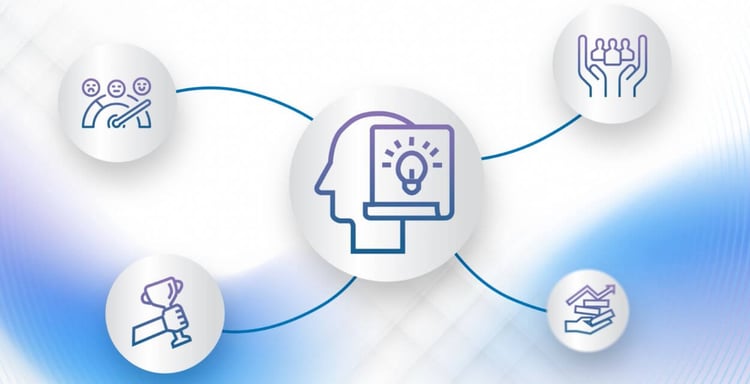
The increasing adoption of automation technologies has the potential to enhance productivity, streamline processes, and reduce costs. However, it is crucial to balance automation with the human touch to ensure a positive employee experience. Organizations need to:
- Identify the right tasks for automation: Carefully evaluate which tasks are suitable for automation, considering the impact on employee roles, responsibilities, and satisfaction.
- Upskill and reskill employees: Invest in training and development programs to equip employees with the skills and knowledge needed to adapt to an increasingly automated work environment.
- Maintain human oversight and intervention: Ensure that automation is not implemented in isolation, but rather complements human expertise and judgment, particularly in areas that require creativity, empathy, and complex decision-making.
- Communicate automation plans clearly and transparently: Openly communicate automation plans with employees, addressing concerns and providing opportunities for feedback and input.
- Prioritize human connection and engagement: Despite advancements in technology, prioritize human connection and engagement by fostering a supportive work environment that values teamwork, collaboration, and personal interactions.
Strategies for Improving Employee Experience
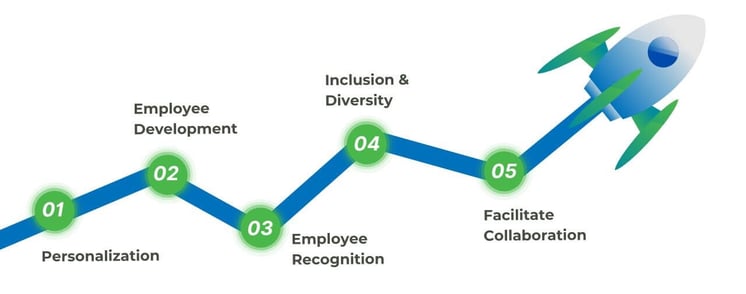
By implementing effective strategies that prioritize employee well-being, satisfaction, and growth, organizations can cultivate a thriving workplace culture that drives productivity, innovation, and success. Here are some key strategies for improving employee experience:
1. Personalization of Employee Journeys
Tailor the employee experience to cater to individual needs, preferences, and aspirations. This includes providing personalized onboarding experiences, offering flexible work arrangements, and providing opportunities for employees to choose their work tools, technologies, and training programs.
2. Investing in Employee Development Programs
Provide comprehensive employee development programs that support continuous learning, skill enhancement, and career advancement. Offer a variety of training formats, including online courses, workshops, mentorship programs, and tuition reimbursement opportunities.
3. Building a Culture of Recognition and Appreciation
Create a culture that recognizes and appreciates employee contributions, both big and small. Implement regular recognition programs, provide timely feedback, and celebrate employee successes to foster a sense of value and belonging.
4. Fostering an Inclusive and Diverse Workplace
Embrace diversity and inclusion by creating a workplace that values different perspectives, backgrounds, and experiences. Implement initiatives to promote equal opportunities, address unconscious biases, and foster a sense of belonging for all employees.
5. Supporting Remote and Hybrid Work Models
Effectively support remote and hybrid work arrangements by providing employees with the necessary tools, technologies, and support systems. Equip managers with the skills to lead remote teams, facilitate communication and collaboration, and maintain a cohesive company culture.
By implementing these strategies, organizations can create a positive and engaging employee experience that drives employee satisfaction, retention, and overall organizational success.
Key Points
- Employee experience (EX) encompasses all aspects of an employee's journey, from recruitment to onboarding to development to performance evaluation to offboarding.
- A positive EX leads to increased employee engagement, productivity, innovation, and retention.
- A negative EX leads to disengagement, attrition, and a damaged employer brand.
- Organizations can invest in EX by creating a positive candidate experience, providing a strong onboarding program, fostering a supportive work environment, offering opportunities for learning and development, recognizing and rewarding employees, and creating a diverse and inclusive workplace.
Strategic Value of Investing in Employee Experience
Investing in EX is a strategic imperative for organizations that want to achieve sustainable business growth and success. A positive EX leads to:
- Increased employee engagement and productivity
- Improved talent attraction and employee retention
- Enhanced customer satisfaction and loyalty
- Stronger employer brand and reputation
- Increased innovation and adaptability
- Reduced absenteeism and presenteeism
- Enhanced risk management and compliance
- Strengthened employee advocacy
- Improved employee referrals
Continuous Improvement
EX is not a one-time initiative; it is an ongoing process that requires continuous improvement. Organizations that are committed to creating a positive EX will reap the benefits of a more engaged, productive, and innovative workforce.
Where to Start
Creating a positive employee experience (EX) is crucial for organizational success. Fortunately, Macorva EX provides a powerful suite of tools to help businesses measure and improve their EX.
Macorva EX: Employee Experience powered by AI
Macorva EX leverages generative AI to transform employee experience data into actionable insights for both managers and employees. With its comprehensive features, Macorva EX empowers organizations to:
![]() Gather Real-time Feedback
Gather Real-time Feedback
Utilize mobile-first employee surveys to capture feedback from employees anytime, anywhere.
![]() Understand Sentiment with AI
Understand Sentiment with AI
Harness AI-powered sentiment analysis to gauge the overall tone and sentiment of employee feedback, uncovering valuable insights into their attitudes and concerns.
Streamline 360 Feedback
Implement streamlined 360 feedback processes to gather holistic perspectives on employee performance from colleagues, managers, and clients.
Automate Lifecycle Surveys
Automate lifecycle surveys to gather feedback at key stages of the employee journey, providing continuous insights into their experiences.
Design Customized Surveys
Create any kind of survey or feedback form to collect the specific information you need to address your unique EX challenges.
Analyze Data Intuitively
Leverage intuitive, user-friendly data analysis tools to gain a clear understanding of employee feedback and identify areas for improvement.
Uncover AI-powered Insights
Employ automated AI-powered data analysis and insights to extract hidden patterns and trends from employee feedback, providing actionable recommendations for EX improvement.
Benchmark Engagement and Drivers
Utilize engagement benchmarks and driver analysis to compare your organization's EX levels against industry standards and identify the key factors influencing employee engagement.
Empower Coaching with AI
Implement automated AI-powered employee coaching to provide personalized guidance and support to employees, fostering their growth and development.
Enable Managers with AI
Employ automated AI-powered manager enablement to equip managers with the skills and knowledge to effectively address employee concerns, improve EX, and drive team success.
![]() Transform Performance Management
Transform Performance Management
Revolutionize performance management with AI-powered tools that instantly generate OKRs, performance reviews, development plans, PIPs, meeting agendas, and more from manager notes and employee experience data.
Take the First Step
The journey of employee experience (EX) is ongoing and evolves with each phase of the employee lifecycle. It demands continuous nurturing and refinement. To effectively oversee and adapt to the shifting landscape of an employee's career, you need a comprehensive employee experience management solution that enables you to measure and analyze engagement, performance, and development consistently.
Macorva steps in as the ideal partner for this journey, offering a complete employee experience solution that keeps your organization on course. Our platform empowers you to boost employee engagement, enhance performance, and foster professional growth—all within a single, user-friendly interface. With Macorva, you can ensure that your team not only stays aligned with organizational goals but also thrives, contributing to a robust, high-performing workplace culture. Harness the power of data and AI to create a positive and engaging employee experience that drives employee satisfaction, productivity, and long-term business success. Contact us today to learn how Macorva EX can transform your employee experience journey.
